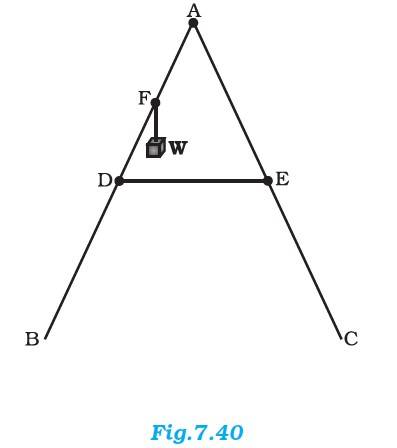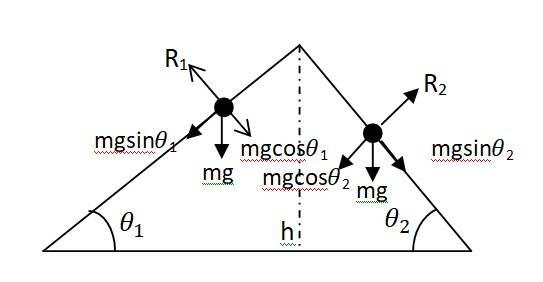System of Particles and Rotational Motion
Get insights from 71 questions on System of Particles and Rotational Motion, answered by students, alumni, and experts. You may also ask and answer any question you like about System of Particles and Rotational Motion
Follow Ask QuestionQuestions
Discussions
Active Users
Followers
New answer posted
6 months agoContributor-Level 10
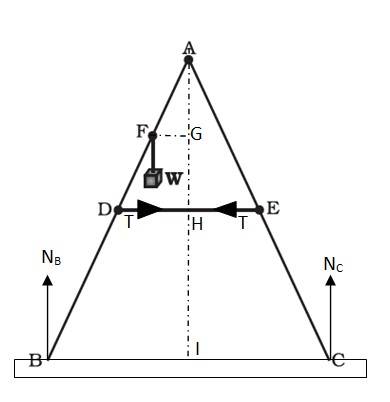
The given situation can be shown as
NB = force exerted on the ladder by the floor point B
NB = force exerted on the ladder by the floor point B
T = Tension in the rope
BA = CA = 1.6 m, DE = 0.5 m and BF = 1.2 m
Mass of the weight, m = 40 kg
The perpendicular drawn from point A on the floor BC, this intersects DE at mid-point H.
Δ ABI and ΔACI are congruent. Therefore BI = IC, I is the mid-point of BC. DE is parallel to BC.
BC = 2 x DE = 1 m and AF = BA – BF = 0.4 m…… (i)
D is the mid-point of AB, hence we can write
AD = (1/2) x BA = 0.8 ……. (ii)
Using equation (i) and (ii), we get FE = 0.4 m
Hence, F is the mid-point of AD.
Hence G will
New answer posted
6 months agoContributor-Level 10
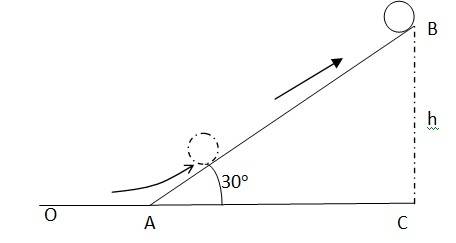
Initial velocity of the cylinder, v = 5 m/s
Angle of inclination, = 30
Height reached by the cylinder = h
Energy of the cylinder at point A:
KE rot + KEtrans
(1/2) I + (1/2) m
Energy of the cylinder at point B = mgh
Using the law of conservation of energy
(1/2) I + (1/2) m = mgh
Moment of inertia of the solid cylinder I = (1/2) mr2
Hence (1/2)(1/2)mr2 + (1/2) m = mgh
We also know v = r
(1/4)m + (1/2) m = mgh
(3/4) = gh
h = (3/4)( = (3/4)(25/9.81) = 1.91 m
In Δ ABC, = , AB = BC / = 3.82 m
Hence the
New answer posted
6 months agoContributor-Level 10
Mass of the oxygen molecule, m = 5.30 * 10-26 kg
Moment of inertia, I = 1.94*10-46 kg m2
Velocity of the oxygen molecule, v = 500 m/s
the separation of atoms in oxygen molecule = 2r.
the mass of each oxygen atom = (m/2)
Moment of inertia I can be calculated as I = (m/2)r2 + (m/2)r2
hence r =
r = sqrt (1.94*10-46 / 5.30 * 10-26 = 6.05 x 10-11
It is given that KErotation = KEtranslation
(1/2)I = (2/3) (1/2)mv2
= (v/r)
= 6.8 x 1012 rad/s
New answer posted
6 months agoContributor-Level 10
Radius of the hoop, r = 2 m, mass of the hoop, m = 100 kg, velocity of the hoop, v = 20 cm /s = 0.2 m/s
Total energy of the hoop = Translational KE + Rotational KE = m +
Moment of inertia about the centre, I = mr2
So the total energy = m +
Since v = r we get
Total energy = m + =
Required work to be done = 100 x 0.2 x 0.2 J = 4 J
New answer posted
6 months agoContributor-Level 10
(a) Let the mass of the sphere = m
Height of the plane = h
Velocity of the sphere at the bottom of the plane = v
At the top of the plane, the total energy of the sphere = potential energy = mgh
At the bottom of the plane, the sphere has both translational and rotational energies.
Hence, total energy = (1/2)mv2 + (1/2)I
Using the law of conservation of energy, we can write: (1/2)mv2+ (1/2)I = mgh …(1)
For a solid sphere, the moment of inertia, I = (2/5)mr2
The equation (1) becomes (1/2)mv2 + (1/2)( (2/5)mr2 = mgh
(1/2) v2 + (1/5)r2 = gh
From the relation v = , we get
(1/2) v2+ (1/5) v2= gh
v =
Since v depends on
New answer posted
6 months agoContributor-Level 10
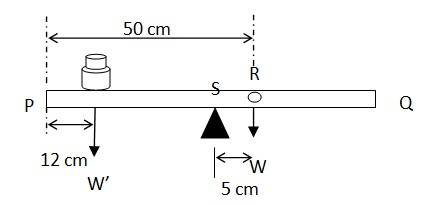
Mass of the meter stick = W
Mass of each coin = 5 g
When the coins are placed 12 cm away from the end P, the centre of mass gets shifted by 5 cm from point R towards the end P. The centre of mass is located at a distance of 45 cm from point P.
The net torque will be conserved for rotational equilibrium about point R,
10 x (45-12) – W' (50-45) = 0
W' = (10 x 33)/5 = 66 g
New answer posted
6 months agoContributor-Level 10
Radius of the original disc = R

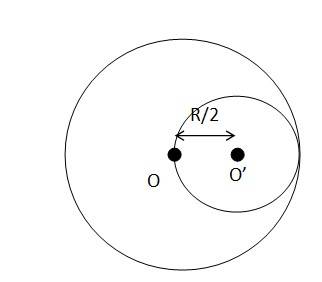
Mass of the smaller disc = = (1/4) = M/4
Let O and O' be the respective centers of the original disc and the cut out disc respectively. As per the definition of the centre of mass, the centre of mass of the original disc is supposed to be concentrated at O, while that of the smaller disc is supposed to be concentrated at O'.
It is given, OO' = R/2
After the smaller disc has been cut from the original, the remaining portion is considered to be a system of two masses. The two masses are
M – concentrated at O and M/4 concentrated at O'
Let x be the distance through which the centers of mas
New answer posted
6 months agoContributor-Level 10
Angular speed of the rotor, = 200 rad/s
Torque, = 180 Nm
Power required, P = x = 180 x 200 = 36 x103 W = 36 kW
New answer posted
6 months agoContributor-Level 10
Mass of the hollow cylinder, m = 3 kg
Radius of the hollow cylinder, r = 40 cm = 0.4 m
Applied force, F = 30 N
The MI of the hollow cylinder about its axis,
I = = 3 x 0.4 x 0.4 = 0.48 kgm2
Torque, = 30 x 0.4 = 12 Nm
For angular acceleration , torque is given by
= I x or
/ I = 12 / 0.48 = 25 rad/s
Linear acceleration = r x = 0.4 x 25 = 10 m/s2
New answer posted
6 months agoContributor-Level 10
(a) Initial angular velocity, = 40 rev/min, let the final angular velocity be
Let the moment of inertia of the boy with hands stretched be I1 and
M.I. with folded hands be I2
Given I2 = (2/5) I1
Since no external force acts on the boy, the angular momentum will remain constant.
Hence I1 = I2 , I1/I2) x = (5/2) x 40 = 100 rev/min
(b) Kinetic energy Ev = (1/2)I
Hence ( Final KE / Initial KE ) = (I2 )/ (I1 ) = { (2/5) I1 x 100 x 100 } / { I1 x 40 x 40 }
= 2.5
Taking an Exam? Selecting a College?
Get authentic answers from experts, students and alumni that you won't find anywhere else
Sign Up on ShikshaOn Shiksha, get access to
- 65k Colleges
- 1.2k Exams
- 679k Reviews
- 1800k Answers

